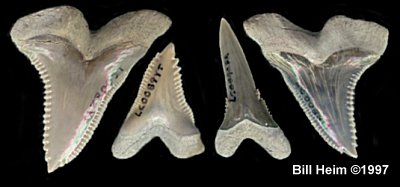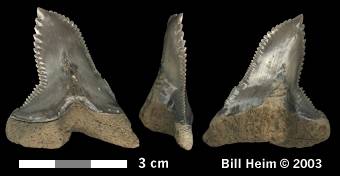|

 The teeth of Hemipristis serra are amongst the easiest to identify both to species and
tooth position. The image includes a large upper
anterior, an upper lateral, a lower anterior, and a lower lateral. All are from the Yorktown
except the lower anterior which is from the Pungo River formation.
The teeth of Hemipristis serra are amongst the easiest to identify both to species and
tooth position. The image includes a large upper
anterior, an upper lateral, a lower anterior, and a lower lateral. All are from the Yorktown
except the lower anterior which is from the Pungo River formation.
The spike-like lower anteriors are often mis-identified as being from a Sand tiger shark
(Carcharias) due to the narrow blade, thick roots and cusplets, albeit different.
Hemipristis serra is a very common find in Miocene deposits and becomes larger
though less numerous in the Pliocene. It struggled on until the Pleistocene of Indonesia
before vanishing. Its close modern relative, H. elongata lives only in the Western
Pacific and Indian Ocean regions. It grows to a maximum of about 7 feet (2.5m) and has a
small mouth (the roots of the teeth overlap) and large though not enormous teeth at that size.
A large H. elongata might have teeth 2 - 2.5cm in slant height. Large fossil H. serra
teeth from Florida can approach 7.5cm in size.
 |
Fig. 1 - Hemipristis serra
labial view of Pungo River & Yorktown specimens
The largest in this image is 52mm in slant height. |
 |
Fig. 2 - Hemipristis serra, pathologic
Lee Creek, North Carolina |
|